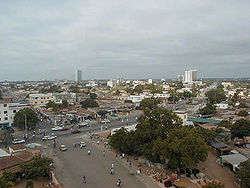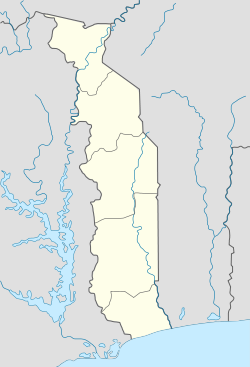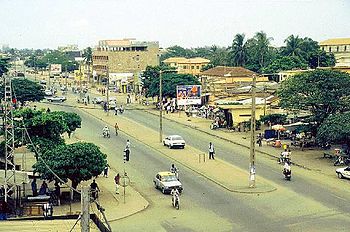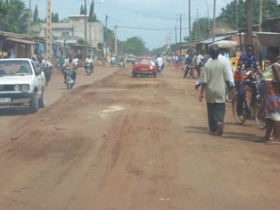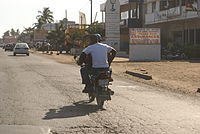
Lomé
Did you know...
SOS Children volunteers helped choose articles and made other curriculum material Sponsor a child to make a real difference.
| Lomé | |||
|---|---|---|---|
| — City — | |||
| Panoramic view of Lome | |||
|
|||
|
|
|||
| Coordinates: 6°8′16″N 1°12′45″E Coordinates: 6°8′16″N 1°12′45″E | |||
| Country | |||
| Region | Maritime Region | ||
| Prefecture | Greater Lomé | ||
| Government | |||
| • Mayor | Aouissi Lodé | ||
| Population | |||
| • Total | 737,751 | ||
| Time zone | UTC + 0 | ||
Lomé, with an estimated population of 737,751, is the capital and largest city of Togo. Located on the Gulf of Guinea, Lomé is the country's administrative and industrial centre and its chief port. The city exports coffee, cocoa, copra, and palm kernels. It also has an oil refinery.
History
The city was founded in the eighteenth century by the Ewe people.
The city's population grew rapidly in the second half of the twentieth century. Indeed, if the city had approximately 30,000 inhabitants in 1950, by 1960 (the year Togo gained its Independence from France) the population had reached 80,000 and 200,000 by 1970.
From the year 1975, investments were increasingly huge, but not always in areas which had been targeted for development, and Togo, being a small country open to all winds, was a hub of trade between its more powerful neighbors. At the same time, it was a tragedy because of the deteriorating railways, which have an important role in serving the suburbs of the city.
Moreover, one can see the development of market gardening around the city, spurred by growing unemployment, rural migration and the demand for vegetables. Market gardening, first extended to the north, is mainly on the beach (the sand is very salty), and planting hedges provides protection.
The various studies of the land market of the city show that the areas are quite heterogeneous, combining opulent villas and modest housing, without social and spatial division of the city. This is because the Loméens are very attached to their patch of land and what they call their "home" (at home). This has led to a land freeze. But even though the city is not socially divided, the fact remains that Lomé is experiencing increasing problems related to garbage collection, and the fight against unhealthy urban living conditions has become a priority of the city and its inhabitants.
Lome is a city that is changing and developing at breakneck speed, to the rhythms of night life, the hustle and bustle of the general market, cyber cafes, motorcycles / taxis (zemidjans) and cargo the in free zone of the port of Lomé.
Geography
On its inception, Lomé was trapped between the lagoon in the north, the Atlantic Ocean to the south, the village of Bè in the east and the border of Aflao, Ghana in the West. Today the city has seen a massive growth with the oil refinery in the East.
Neighborhoods in Lomé include Ablogamé, Adawlato, Amoutivé, Bé, Dékon, Forever, Kodjoviakopé, Noukafou, Nyékonakpoé, Tokoin and Xédranawoe.
Neighbourhoods in the north of the city are almost separated from the centre by a lagoon. The lagoon itself covers 30 km².
Lomé is recognized by the Togolese government as a Municipal Greater Urban Area. Cities and towns in the Greater Lomé Metropolitan Area include: Aflao (Ghana), Agbalépédogan, Akodésséwa, Anfamé, Baguida, Kanyikopé, Kélékougan, Lomé II, Totsigan, Adidogome, Kegue and Totsivi. Services of the Municipality of Lomé far beyond the boundaries of the Gulf and the town north and east of the city.
Distance of Lomé from other Togolese cities
- Lomé/ Tsévié 35 km
- Lomé/ Aného 45 km
- Lomé/ Tabligbo 90 km
- Lomé/ Notsé 100 km
- Lomé/ Kpalimé 121 km
- Lomé/ Atakpamé 167 km
- Lomé/ Blitta 273 km
- Lomé/ Sokodé 355 km
- Lomé/ Bafilo 404 km
- Lomé/ Bassar 412 km
- Lomé/ Kara 413 km
- Lomé/ Kandé 503 km
- Lomé/ Mango 592 km
- Lomé/ Dapaong 662 km
Climate
As in most equatorial climates, the city has two rainy seasons, the first starts in April and ends in July, then a second rainy season starts in early September and ends in late November.
The heat is constant, the average maximum temperature in the shade is on average 30 °C in the afternoon, and the average minimum temperature is 23 °C in the morning. Earlier this year, a dry wind from the Sahara brought down the temeprature to as low as 19 °C in the morning.
The climate of Lomé is also greatly influenced by the ocean. The heat is stable, without excessive peaks, and the wind coming from the sea, makes it quite pleasant.
The city has a distinctively low rainfall for this latitude, in fact, Lomé enjoys a micro climate that allows her to reach a low rainfall for the region (800 mm per year). By comparison, Paris receives an average of 650 mm per year.
Politics
International agreements
A number of international agreements have been signed in Lomé.
Lomé Convention
The Lomé Convention is a trade and aid agreement between the European Union (EU) and 71 African, Caribbean, and Pacific (ACP) countries. It was first signed on February 28, 1975 in Lomé. The first Lomé Convention (Lomé I), which came into force in April 1976, was designed to provide a new framework of cooperation between the then European Community (EC) and developing ACP countries, in particular former British, Dutch, Belgian and French colonies. It had two main aspects. It provided for most ACP agricultural and mineral exports to enter the EC free of duty. Preferential access based on a quota system was agreed for products, such as sugar and beef, in competition with EC agriculture. Secondly, the EC committed to the ECU for 3 billion in aid and investment in the ACP countries.
The convention was renegotiated and renewed three times. Lomé II (January 1981 to February 1985) increased the aid and investment expenditure for the ECU to 5.5 billion. Lomé III came into force in March 1985 (trade provisions) and May 1986 (aid), and expired in 1990; it increased commitments to ECU by 8.5 billion. Lomé IV was signed in December 1989. Its trade provisions cover ten years, 1990 to 1999. Aid and investment commitments for the first five years amounted to 12 billion. In all, some 70 ACP countries are party to Lomé IV, compared with the 46 signatories of Lomé I.
Lomé Peace Accord
The Lomé Peace Accord was a peace agreement between the warring parties in the civil war in Sierra Leone. With the assistance of the international community, Sierra Leone President Ahmad Tejan Kabbah and Revolutionary United Front leader Foday Sankoh signed the Peace Accord on July 7, 1999. However, the agreement did not last and the Sierra Leone Civil War continued for two more years.
Demographics
| Demographic evolution of Lomé | |
|---|---|
| 1892 | 1 500 inhabitants |
| 1896 | 2,000 inhabitants |
| 1900 | 3,000 inhabitants |
| 1904 | 4,000 inhabitants |
| 1907 | 6,000 inhabitants |
| 1911 | 8,000 inhabitants |
| 1930 | 15,000 inhabitants |
| 1938 | 18,000 inhabitants |
| 1950 | 33,000 inhabitants |
| 1955 | 43,000 inhabitants |
| 1960 | 85,000 inhabitants |
| 1970 | 186,000 inhabitants |
| 1981 | 375 499 inhabitants |
| 1990 | 450,000 inhabitants |
| 1997 | 573,000 inhabitants |
| 2006 | 737,751 inhabitants |
Economy
Located 200 km from Accra and 150 km from Cotonou, Lomé is an important port, including a free trade zone opened in 1968. It exports phosphates, coffee, cocoa, cotton and palm oil, much of the transit going to the neighbouring countries of Ghana, Mali, Niger and Burkina Faso. The port also houses an oil refinery.
The University of Lomé is now known in West Africa. The country's main airport is situated outside the city. The tallest building in Lomé, and throughout the country, is the Hotel Corinthia (36 storeys or 102m), a 5-star hotel and very modern.
The city in general has great potential, because tourism is growing in the country. However, political instability that began to surface in the passing years and continues today has seriously affected the country's tourism sector. In 2003, the country received 57,539 visitors, an increase of 1% compared to 2002. 22% of tourists came from France, 10% of Burkina Faso and 9% were from Benin
Architecture
Notable landmarks in the city include Lomé Grand Market, the Togo National Museum in the Palais de Congrés, a fetish (voodoo) market, Lomé Cathedral, beaches and the former wharf.
The city of Lomé is a typical African city in the sense that many styles, influences, and traditions are mixed. The landscape combines red earth, with grand boulevards and large squares, green gardens and colorful houses.
There are some remnants of colonial architecture from the turn of the century, such as arcades and galleries and the Cathedral of the Sacred Heart designed in the German Gothic style. There are also many modern buildings like the headquarters of the BCEAO, , the BTCI, the magnificent edifice of ECOWAS, Hotel de la Paix, the Hotel Mercure Sarakawa, Palm Beach Hotel and the famous 2 Fevrier Sofitel Hotel, rising to 102 meters.
Not far away is the Lomé Grand Market, with a large 3-storey hall. It sells everything from red peppers, green lemons, dried fish, combs, travel bags, and traditional medicinal remedies. On the first floor is the "Nana Benz", which is noted for its clothing. Nearer the centre of the city, there is the Akodessewa market, which is much more specialized than the general market. There are fetishes, gongons, and gris-gris.
The coast is considerably less frantic than the market, with local fishermen quietly pushing their large boats out to sea. To the west of the city is a residential area which faces the sea. The area has long streets, punctuated by official government buildings including the Palace of Justice and the various embassies and consulates. Farther north, near the Monument of Independence, is the house of the Rally of the Togolese People (RPT), a major convention centre, within which lies the Togo National Museum. The museum contains collections, jewelry, musical instruments, dolls, pottery, weapons and many other objects showing the arts and traditions.
Education
The University of Lomé (previously called University of Benin) is located in Lomé Tokoin Campus. Also, The British School of Lome is located in the city.
Transportation
The city is served by the Lomé-Tokoin Airport. The tallest building in Lomé and in all of Togo is the 2 Fevrier Sofitel Hotel building. The former railway line to Blitta runs from the airport to the city.
Notable residents
- Umar Farouk Abdulmutallab, charged with attempting to blow up Northwest Airlines Flight 253 to Detroit on Christmas Day 2009.
- Emmanuel Adebayor, footballer for Togo and Manchester City F.C.
- King Mensah, popular Afropop musician, and philanthropist
- Moustapha Salifou, footballer for Togo and Aston Villa
Sister cities
 Duisburg, Germany
Duisburg, Germany Shenzhen, China
Shenzhen, China Taipei, Taiwan
Taipei, Taiwan Bay City, Michigan, United States
Bay City, Michigan, United States
